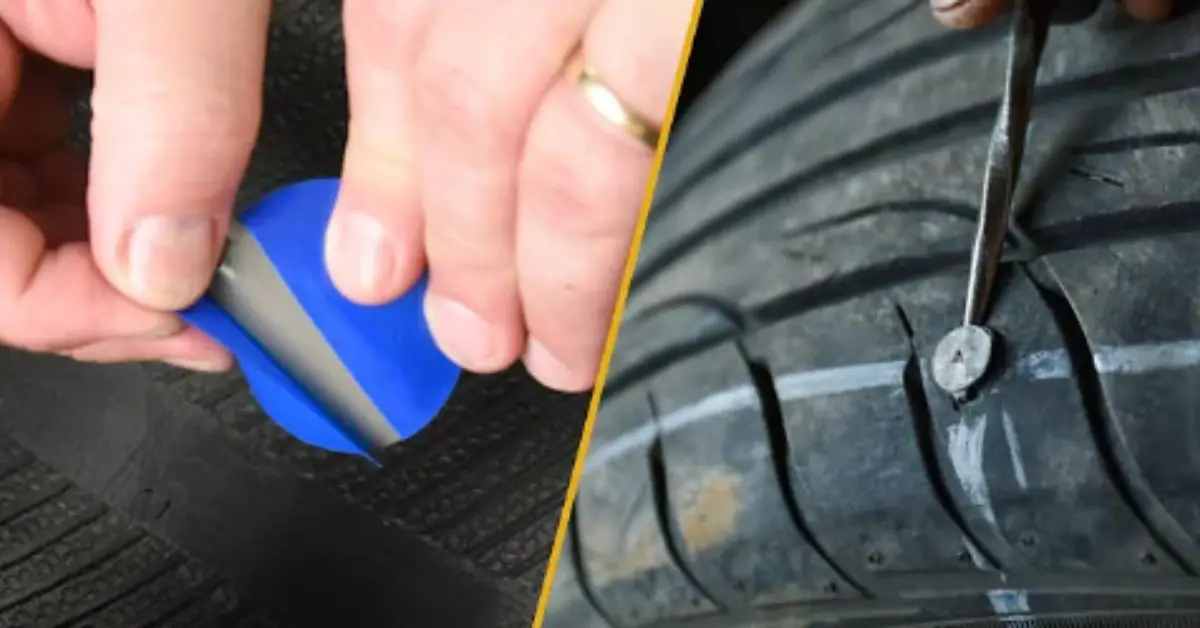Ever heard that dreaded thump-thump-thump while cruising down the highway? It’s a flat tire, an all-too-common occurrence for motorists worldwide. Now you’re faced with the age-old conundrum: to patch or to plug? This question has sparked debates among drivers for years, with no definitive answer in sight. It all hinges on the type of tire damage and the tire’s condition.
Tire patches and plugs each have their strengths and drawbacks. Plugs, often made from rubber or latex, offer a quick fix without the need to remove the tire. Patches, on the other hand, provide a more permanent solution, but their installation can be more challenging.
Understanding Tire Repair: Plugs and Patches
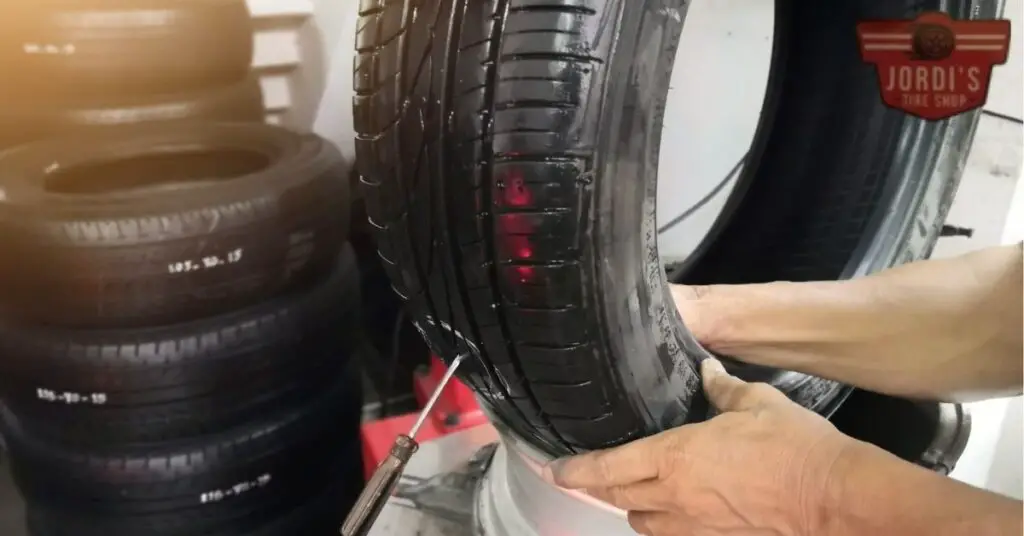
Handling the industry of tire repairs can be a tangled web of patches, plugs, and professional advice. A clear understanding of tire plugs and patches, their application, and relative merits can empower you to make a knowledgeable choice when confronted with a pesky punctured tire.
What is a Tire Plug?
A tire plug, quite literally, plugs the hole in your punctured tire, much like a stopper in a wine bottle. This sticky, flexible piece of rubber performs an important job: it blocks the hole and stops the air from escaping. Here’s how it works. The puncture in your tire is located and then a tool called a reamer, with raspy edges, is inserted into the hole and moved multiple times. This process enlarges the puncture and cleans out any debris, guaranteeing a secure fit for the rubber plug. Following the preparation, the rubber plug is inserted into the eye of the plug insertion tool, an adhesive is applied, and then the tool, with the plug, is inserted two-thirds of the way into the puncture location and quickly pulled back out, leaving the plug in the hole to seal the puncture. Any excess plug material protruding from the tire’s surface is then trimmed off. It’s a simple and straightforward process, but its longevity and reliability have been a topic of debate among auto enthusiasts.
What is a Tire Patch?
On the other hand, tire patches take a slightly different approach to puncture repair. A patch is bonded over the hole in the tire and inflated along with the rest of the tire. This method provides a more permanent solution than a plug but requires more effort to install. To patch a tire, the tire must first be removed from the rim. A 2-inch diameter around the puncture is then cleaned with a die grinder to prepare the area for the patch. The patch is applied from inside the tire, pushed through to the outside, sealed, and allowed to dry. To provide a comprehensive solution, a plug-patch combo product, which combines the benefits of both methods, is often employed. But, do remember that not all tire damage can be repaired. Certain issues, like tire bubbles, denote a dangerous situation that necessitates new tires.
Whether to opt for a tire plug or a patch repair depends on your unique situation. Now, equipped with knowledge, you can make an well-informed choice.
Factors to Consider When Choosing Between Plugs and Patches
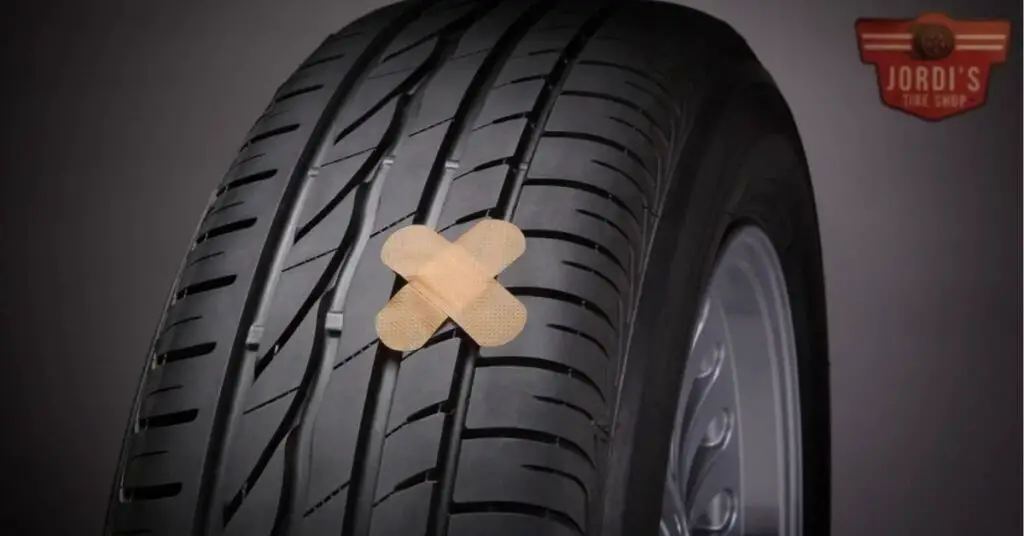
In the search to solve tire issues, comprehending the dynamics of tire plugs and patches offers crucial insights. Let’s investigate into how they operate, their appropriateness, and durability.
How Do They Work?
Tire plugs bear a distinction by their mode of employment. Placed from the tire’s outside, they serve to seal punctures using a flexible rubber stem. Sounds simple, yes, but bear in mind this process involves driving the plug through the puncture from the tire’s exterior. You’re actually threading the needle, so to speak.
But, tire patches necessitate a more involved process. You need to dismount the tire from the rim, make a clean surface on the interior over the area of the puncture and administer the patch from inside. It’s more of a surgical procedure if you might compare. And yes, it’s no surprise that the combination of plugs and patches grows in popularity – this dual approach entering the puncture from both inside and out, essentially marrying the virtues of both methodologies.
When Can They Be Used?
Understanding when to employ either plugs or patches can be quite instrumental in your tire repair decision-making. Fortunately, these tire therapy options aren’t mutually exclusive. For instance, you got a puncture on a lonesome road? A plug offers a swift solution. They’re perfect for emergency fixes, because of their ease of application, getting you back on the road ASAP.
But not all fixes are quick and temporary. Entrust the more permanent answers to patches. They are applicable when the damage is limited to the tread area and when the hole is not exceeding ¼ inch in diameter.
How Long Do They Last?
The lasting potential of each fix varies, and this heavily influences the choice between plugs and patches. Tire plugs wield an impressive longevity record, with many users reporting that they last reliably till the tire’s end of life. Yes, quite tenacious!
Patches, though demanding more effort to install, hold their own in the durability arena. Regarded as the more lasting solution, they secure the puncture spot from inside the tire, providing a steadfast seal against pesky leaks.
Nevertheless, remember a plug patch is the safest and surest solution even though being labour intensive. The fusion of quick-fix and permanency makes it stand out as the most practical and assured tire repair solution. So, choose wisely, considering both the immediate circumstance and the longer-term resilience of the repair.
Comparing the Safety of Plugs and Patches
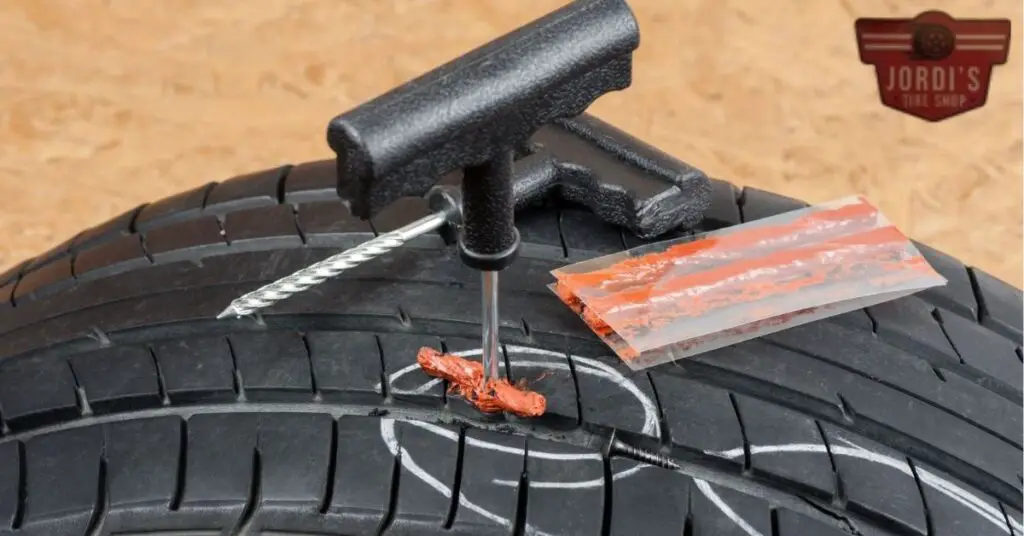
When it comes to tire safety, a crucial factor in the plugs vs patches debate is the location of the puncture. The plug method reigns supreme, albeit only effective when the puncture isn’t too close to the tire sidewall. The United States Tire Manufacturers Association (USTMA) approves of this method exclusively. But, like any other method, it’s not without its risks. Cases of tire failures attributed to plug repairs have been reported, highlighting the importance of suitability and precision during application.
For those hesitant about plugs due to fear of failure, you’ll find comfort in knowing many motorists have driven countless miles on plugged tires without any issues. Nevertheless, it’s essential to remember that reported failures often represent an unfortunate subset of tire plug users whose experiences ended tragically.
The simplicity of a plug can be deceiving. A closer look might reveal it being a part of a combo repair consisting of a plug-patch. This method involves the use of a rubber stem in the center of an inner patch. It’s not just a simple plug – it works by pulling out through the puncture hole and then getting trimmed. This technique is effective in sealing the steel belts from moisture, a fundamental step to prevent tire failure.
Patch use has evolved over time. With the rise in radial tires, the use of string plugs are now prohibited. This prohibition was due to instances of air getting between the belts, leading to tire separation. Similarly, patches lost their sole repair status due to the risks associated with steel belts rusting from outside exposure. As a result, plug-patch combos became the favored solution, combining the seal power of the inner liner plug with the void filling capability of a patch.
Safety concerns extend beyond selection of the repair method. Speed and load are two critical factors to keep in mind. Some drivers have reported success with plugs at high speeds, especially during long trips. But, this isn’t a one-size-fits-all scenario. Individual experiences may differ, highlighting that safety involves the interplay of repair type, driving conditions, and personal responsibility.
Practical Guide on How to Plug a Tire
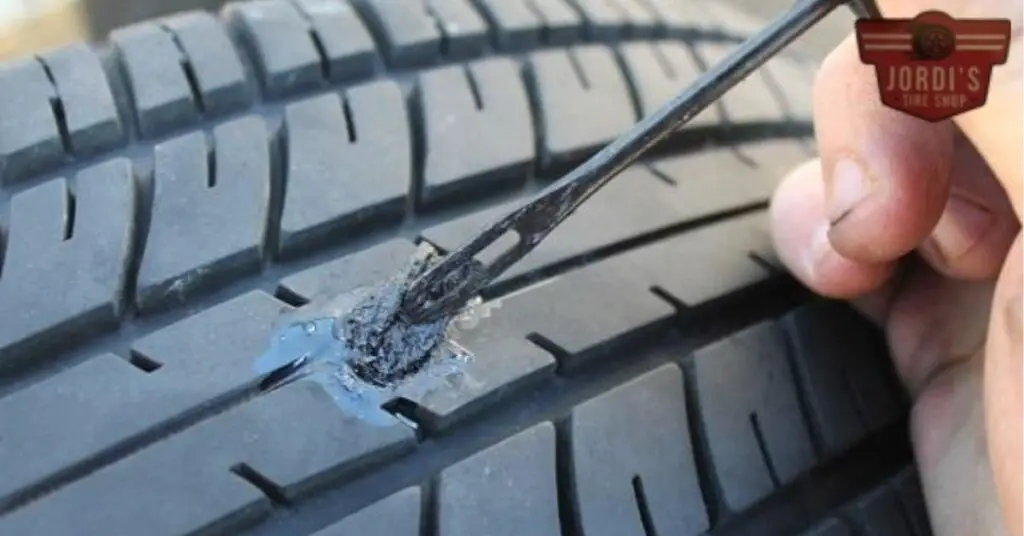
Patching and plugging are two popular methods to fix a flat tire. These methods come into discussion often when drivers are faced with a tire puncture. While these methods may be seen as contradictory they actually follow a similar process in action. To plug a tire correctly, it’s essential to understand the process and have the right tools. Let’s jump into how you can plug a tire effectively.
The first tool is a plug, sticky rubber piece, which is threaded through a piece of metal, often referred to as the insertion tool. Upon finding the puncture hole on your tire, you’ll prepare the plug by threading it through the metal insertion tool.
A reamer tool, featuring raspy edges, comes into play next. Use this tool to clean the hole and prepare it for the plug. It’s implemented with a rotary motion to ensure the puncture hole is clean and adequately sized for the plug.
Once the puncture hole is clean, comes the insertion of the plug. Push the plug into the hole using the metal tool until you find resistance. Experience will help gauge just how far to insert the plug but typically, leaving two-thirds of the plug within the tire is a good rule of thumb.
Next, twist the insertion tool slightly to lock in the plug before the quick removal of the tool. This leaves the plug inside the hole with a portion of it protruding from the tire. Some drivers prefer to trim the excess plug, others let it wear down naturally from driving. This is largely a personal preference.
It’s crucial to bear in mind that plugging a tire offers a temporary workaround. It may hold dependably for a week, a month, even up until the tire’s life ends, but, it’s not uncommon for the plug to fail. Follow up is key – monitoring air pressure and visually inspecting the plug for wear or leakage is important.
Just as important is the notion of timing and circumstance. While some may see success in plugging a tire and moving along, others might operate in an environment or circumstance where a plug is only suitable for 24-48 hours. In such instances, a full patch or tire replacement is likely the safest course of action.
It should be highlighted that some tire professionals have noted concerns about plugging as it potentially compromises the steel within the tire damaging its structural integrity. Given this, tire professionals often recommend a plug-patch combo as the safest and most reliable tire repair solution.
As you navigate these situations, make sure that you understand the caveats, take the time to do a good job, and always double-check your work. This practical guide ensures you are well-equipped for coping with this common driving issue of how to plug a tire.
Practical Guide on How to Patch a Tire
Patching a tire may be a more labor-intensive process than plugging, but it offers a more thorough and dependable fix. The process primarily involves removing the tire, equipping a grinder with a grinding stone, cleaning out the puncture hole, and applying a vulcanized cement patch from the inside out.
Here’s a step-by-step guide for you on how to patch a tire effectively:
- Remove the Tire: Start by removing the tire from your vehicle. It’s necessary to access both the external and internal parts of the tire for a thorough repair.
- Remove the Tire’s Valve Stem Core: The next step is removing the tire’s valve stem core. This permits the air inside the tire to escape, allowing easier work on the puncture site.
- Separate the Tire from the Rim: To access the puncture hole internally, you need to separate the tire from the rim. It ensures maximum visibility and alleviates the application of the patch.
- Clean the Puncture Hole: Use an air die grinder to scrub and clean out the puncture hole. This step ensures the cement later used would adhere properly to the tire.
- Prepare the Area Around the Puncture: With a grinding stone on your grinder, prepare an area around the puncture, making it suitable for cement application.
- Remove Dirt and Debris: Ensure the punctured area doesn’t contain any dirt or debris as these can affect the effectiveness of the patch.
- Apply Vulcanized Cement: Apply vulcanized cement to the inner part of the tire surrounding the puncture. Vulcanizing cement helps bond the patch to the tire and improves its effectiveness.
- Apply the Tire Patch: Once the cement is dry, apply the tire patch from the inside out. Carefully ensure all the edges of the patch fully bond with the cement.
- Seal the Patch: After attaching the patch, consider sealing it for added protection and boosted durability.
- Reassemble the Tire: Finally, put the tire back together and attach it back onto your vehicle.
Keep in mind that all these processes should be performed with utmost precision. But also, remember that not all tires can benefit from patching. The U.S. Tire Manufacturers Association mentions that a tire’s shoulder or sidewall damage is irreparable and such tires should be replaced. Also, punctures larger than 1/4 inch cannot be patched effectively.
So, before you grab your toolkit, ensure that the damage is repairable. If unsure, consult with a professional for guidance.
Key Differences Between Tire Plug and Tire Patch
When it’s about tire repair, considering the key differences between a tire plug and a tire patch proves critical. Each method has its unique features, advantages, and disadvantages, and the optimal choice largely depends on the exact condition and location of the tire damage.
Tire Plugs
A tire plug, usually made of rubber or latex, serves as a quick and effortless solution. It’s ideally used when the tire has been punctured by a blunt object like a nail, causing air leakage. The great thing about plugs is, they can be administered without the hassle of removing the tire from the vehicle. After the puncturing object gets retrieved, the plug fills the hole, halting the air leak. This method is not only less expensive but also quite convenient, especially if you find yourself stranded roadside with a flat tire.
But, it’s crucial to acknowledge that tire plugs might not be the most durable nor the safest option. Plugs may not last long and can potentially inflict further damage on your tires over prolonged use. Also, they aren’t as effective for sealing larger holes.
Tire Patches
Unlike a plug, a tire patch is a more labor-intensive yet comprehensive repair. This method involves removing the tire from the rim and preparing a 2-inch clean radius around the puncture to help efficient bonding. The patch provides an extended coverage, broadcasting from inside the tire through to the outer surface. Given this application technique, patches often offer a more long-lasting repair than plugs.
Still, it’s important to weigh the downsides too. Patching a tire is typically more expensive than plugging, considering you’ll pay for both the patch and labor if you hire professional help. Plus, tire patches require a longer installation time due to the necessary preparation and bonding process.
Plug-Patch Combo
For a comprehensive approach, modern tire repair introduces a one-piece plug-patch combo product. This innovative solution blends the advantageous features of both a plug and a patch, tailoring a repair that is easy to apply, well-sealed, and durable.
Remember, not all tire damage can be repaired. Regardless of your repair technique choice, ensure to evaluate the state of damage and consider seeking expert advice if necessary. Prioritize safety over quick fixes, understand your tire’s condition, and make an well-informed choice.
Making The Decision: Plug or Patch?
Understanding the exact conditions and type of damage to your tire becomes critical in the decision-making process when choosing between a plug or patch. One factor to closely consider is the location of the puncture. It’s vital to note that a plug-patch method is deemed to be the best according to the tire manufacturer association, USTMA, but it’s only feasible if the puncture isn’t too close to the sidewall of the tire.
Experience from many drivers reveals success in using plugs. Over decades of use, there have been minimal issues highlighted. In fact, many have driven thousands of miles using plug repaired tires. But, with all anecdotes, noting counter experiences is critical. Some instances of tire failures could be attributed to a plug repair.
If the conditions happen to be suitable for the plug-patch method, then it’s advantageous to consider it as a viable route. Some views hold that plugs can fail and such situations aren’t unheard of among the driving community.
With these narratives, it’s clear that the decision carries weight. Safety is paramount and any repair solution utilized should serve to enhance it, not jeopardize it. Analogous to other aspects of life, decisions we make about tire repairs echo in the safety and smoothness of our journeys down the road. It’s a blend of long-term safety and immediate convenience that guides us in our choice. You’re encouraged to critically evaluate your situation and make an well-informed choice based on your immediate needs and long-term safety considerations, whether it be a plug, a patch, or a combination of both.
Conclusion
So, you’ve got a flat tire and you’re weighing up the plug vs patch debate. Remember, the best solution depends on the type of damage and the tire’s condition. Plugs are great for a quick fix, but patches are a more permanent solution. But, they do take more effort to install.
If you’re in a pinch, a tire plug could be your best bet. But if you have the time and the damage is limited to the tread area, a patch might be a more reliable option. And don’t forget about the plug-patch combo, which can provide a comprehensive repair.
Bear in mind, though, not all tire damage can be fixed. Sometimes, a new tire is your only safe option. So, before you make a decision, assess the situation carefully.
The safety of your vehicle depends on it. So, whether you choose to plug or patch, make sure you’ve considered all factors. After all, your safety on the road is what matters most.
Related Posts:
- How Much Does an Alignment Cost at Big O Tires? Your Complete Guide
- How Long Can You Drive on a Plugged Tire? Safety Tips and Expert Advice
- How to Fix Tire Cupping: Easy DIY Steps & Expert Tips to Prevent Uneven Wear
- How to Fix Tire Squeaks When Turning: Causes, Solutions, and Prevention Tips
- Plug vs Patch Tire: Which Flat Tire Repair Method is Best for You?
- What Does Service Tire Monitor System Mean? Comprehensive Guide to STMS & Latest Innovations
- How to Cut Tires in Half Safely for DIY Projects and Gardening
- How to Fix Inner Tire Wear: Key Tips for Alignment, Suspension, and Maintenance
- How Long Does a Patched Tire Last? Tips for Maximizing Tire Lifespan

